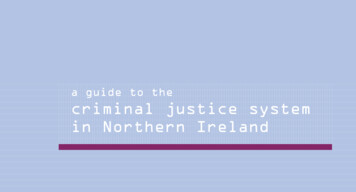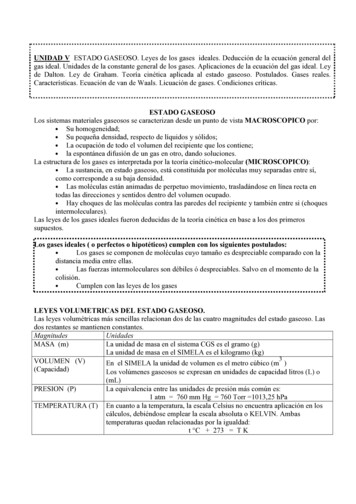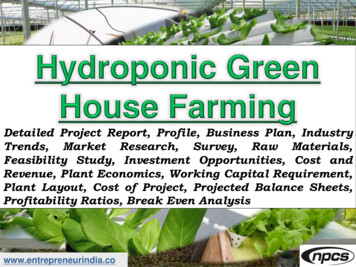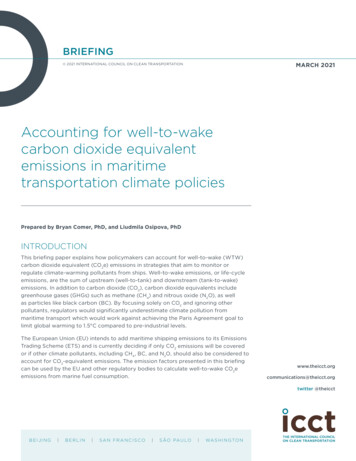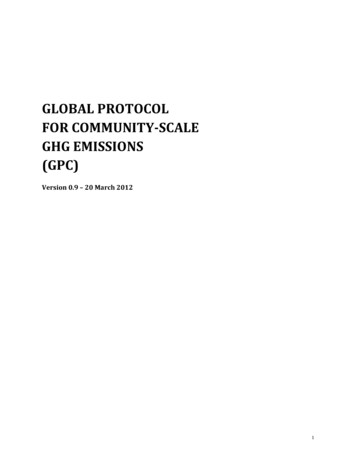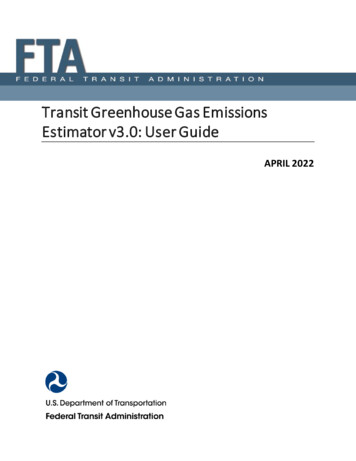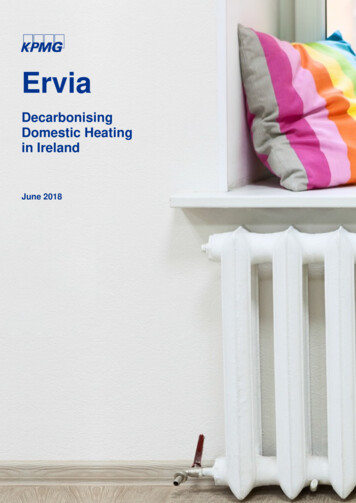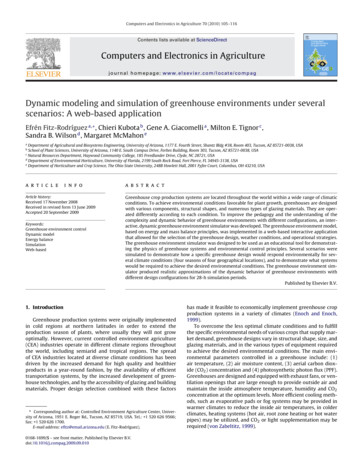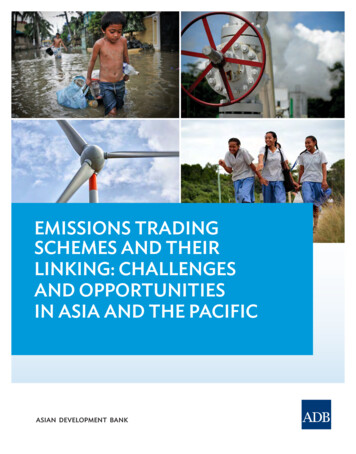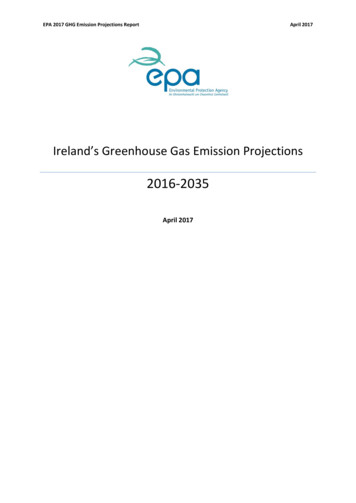
Transcription
EPA 2017 GHG Emission Projections ReportApril 2017Ireland’s Greenhouse Gas Emission Projections2016-2035April 2017
EPA 2017 GHG Emission Projections ReportApril 2017Overview of Ireland’s Greenhouse Gas Emission Projections This report provides an assessment of Ireland’s progress towards achieving its emissionreduction targets set down under the EU Effort Sharing Decision (Decision No 406/2009/EC)for the years 2013-2020 and a longer term assessment based on current projections. Ireland’s 2020 target is to achieve a 20% reduction of non-Emission Trading Scheme (nonETS) sector emissions (i.e. agriculture, transport, the built environment, waste and nonenergy intensive industry) on 2005 levels with annual limits set for each year over the period2013-2020. The EPA has produced two scenarios in preparing greenhouse gas emission projections; aWith Existing Measures scenario and a With Additional Measures scenario. For 2017 projections, the With Additional Measures scenario takes into account an expectedshortfall in achieving full energy efficiency targets and renewable targets for electricity,transport and heat as set out in the National Energy Efficiency Action Plan and NationalRenewable Energy Action Plan. To assess progress towards achieving reduction targets out to 2020 the EPA is usinglegislative limits (for the period 2013-2016) and estimated annual limits (for the period2017-2020) which will possibly be included in a European Commission proposal that takesinto account methodological changes underpinning greenhouse gas emission inventories. For 2020 it is estimated that non-ETS sector emissions are projected to be 4% - 6% below2005 levels by 2020. This compares to the target of 20% below 2005 levels by 2020. To determine compliance under the Effort Sharing Decision, any overachievement of thebinding emission limit in a particular year (in the period 2013 to 2020) can be banked andused towards compliance in a future year. Under both scenarios Ireland is expected toexceed the annual limit in 2016. Under the With Existing Measures scenario, Ireland is projected to cumulatively exceed itsobligations by 13.7 Mt of CO2eq over the period 2013-2020. Under the With AdditionalMeasures scenario, Ireland is projected to cumulatively exceed its obligations by 11.5 Mt ofCO2eq over the period 2013-2020. This takes into account the overachievement of theannual limits in the period 2013-2015 which is banked and used in the years 2016-2020.Using this mechanism Ireland is projected to cumulatively exceed its obligations in 2019. Agriculture and transport dominate non-ETS sector emissions; emission trends from thesesectors will be key determinants in terms of meeting targets with both projected to increasein the period to 2020. There will be new obligations (as yet undefined) for the years 2021-2030. Based on currentemission projections, it is estimated that by 2030 total non-ETS emissions will be 1%-3%below 2005 levels. The estimates of greenhouse gas emissions to 2035 assume acontinuation of the effect of policies and measures that are in place in 2020.
EPA 2017 GHG Emission Projections ReportApril 20171. IntroductionThe Environmental Protection Agency (EPA) produces greenhouse gas emission projections on anannual basis for all sectors of the economy in collaboration with relevant State and other bodies.These projections are compiled to meet EU reporting obligations (Monitoring Mechanism RegulationNo 525/20131) and also to inform national policy development. These projections update thosepublished in March 20162 by the EPA.Much of the discussion in this document focuses on emissions up to 2020 and Ireland’s projectedcompliance under the EU 2020 targets. The document also provides information on the EU andnational policy position context and emission projections beyond 2020.2. ApproachGreenhouse gas emissions were projected to 20353 using two scenarios: a With Existing Measuresscenario and a With Additional Measures scenario.The With Existing Measures scenario assumes that no additional policies and measures, beyondthose already in place by the end of 2015 (latest national greenhouse gas emission inventory), areimplemented.The With Additional Measures scenario assumes implementation of the With Existing Measuresscenario in addition to, based on current progress, further implementation of Governmentrenewable and energy efficiency targets for 2020, as set out in the National Renewable EnergyAction Plan (NREAP) and the National Energy Efficiency Action Plan (NEEAP). For 2017 projections,the With Additional Measures scenario takes into account an expected shortfall in achieving fullenergy efficiency targets and renewable energy targets for electricity, transport and heat as set outin the NEEAP and NREAP.2017 greenhouse gas emission projections were prepared with data provided by a number of keydata providers including: Energy Forecasts provided by the Sustainable Energy Authority of Ireland in March 2017Agricultural forecasts provided by Teagasc in December 2015Energy forecasts were prepared by SEAI in conjunction with the Economic and Social ResearchInstitute (ESRI) and University College Cork. The ESRI use macro-economic projections which areproduced using the COSMO model4. The baseline projections and underlying assumptions aredescribed in Chapter 1 of “Ireland’s Economic Outlook: Perspectives and Policy Challenges”,published on 5th December 20165. Projections on the global economic environment, including oilprices, as based in simulations using the NiGEM model (National Institute Global EconometricModel6) maintained by the National Institute of Economic and Social Research7.1Regulation (EU) No 525/2013 of the European Parliament and of the Council of 21 May 2013 on a mechanism formonitoring and reporting greenhouse gas emissions and for reporting other information at national and Union levelrelevant to climate change and repealing Decision No. date.html3For 2017 reporting the Monitoring Mechanism Regulation (Regulation (EU)) No. 525/2013) requires Member States toreport greenhouse gas emission projections out to e 1 of 15
EPA 2017 GHG Emission Projections ReportApril 2017Projections from the COSMO model were used to produce projections of the energy demandequation time series variables (i.e. demand equations by fuel and sector). The integration of energydemand into the COSMO model is work that is due to be undertaken in 2017.For the With Additional Measures scenario, the determination of expected progress in theimplementation of NREAP and NEEAP targets out to 2020 was coordinated by SEAI and is reflected inthe energy forecasts output as provided to the EPA in March 2017.Forecasted activity data for the agriculture sector (animal numbers, crop areas and fertiliser use) isthe same data provided by Teagasc in December 2015 in advance of the preparation of 2016emission projections. This dataset includes the proposed national herd, crop areas and fertilizer useto meet the overarching objectives of Food Wise 20258.There are anticipated to be changes to the Effort Sharing annual limits and 2020 targets for MemberStates, including Ireland, as a result of changes to reporting guidelines and methodologies whichwere adopted in relation to compiling greenhouse gas emission inventories. Box 1 details thesechanges and how the EPA is dealing with these anticipated changes to the limits in the presentationof these projections.Box 1. New methodologies and UNFCCC reporting guidelines –Impacts on EU Effort Sharing Annual Limits and 2020 TargetsIn accordance with Article 27 of the Monitoring Mechanism Regulation (Regulation (EU)525/2013) the European Commission was required to examine the impact of the use of the2006 IPCC Guidelines for National Greenhouse Gas Inventories and significant changes broughtabout by the UNFCCC methodologies by December 2016.For this year’s projections, the EPA is using legislative limits (for the period 2013-2016) andestimated annual limits (for the period 2017-2020) which will possibly be included in aEuropean Commission proposal (following the above Article 27 review) that takes into accountmethodological changes underpinning greenhouse gas emission inventories. These estimatesare provided to give an indication of how Ireland is likely to perform relative to amended EUtargets and are subject to a Commission proposal being finalised and adopted.The EPA also prepares emission projections for the land use and land use change and forestry sector(LULUCF) however the impact of forest sinks is not included in this compliance assessment. This is inline with EU accounting rules which do not allow the use of forest sinks to meet EU 2020 targets.Member States can, however, achieve compliance through a number of other mechanisms whichare set out in the EU Effort Sharing Decision (Decision No 406/2009/EC). These include borrowing aquantity of its annual emission allocation i.e. limit from the following year, use of transfers fromother Member States and the limited use of international credits from project activities as long ascertain criteria are met.The key macroeconomic assumptions and a more detailed description of the two scenarios areprovided in Appendices I-III.8Food Wise 2025. A 10-year vision for Irish agri-industry. Department of Agriculture, Food and the Marine, age 2 of 15
EPA 2017 GHG Emission Projections ReportApril 20173. Projected performance relative to EU 2020 TargetsThe EU’s Effort Sharing Decision (Decision No 406/2009/EC) set 2020 targets for EU Member Statesincluding Ireland. These targets cover greenhouse gas emissions from sectors that are not includedin the EU Emissions Trading Scheme. For Ireland these sectors cover agriculture, transport, builtenvironment (residential, commercial/institutional), waste and non-energy intensive industry –collectively referred to as non-ETS sector emissions – and Ireland’s target is to achieve a 20%reduction by 2020 on 2005 levels.In addition, there are annual emission limits for the period 2013-2020 to ensure a gradual movetowards the 2020 target. Any overachievement of the binding emission limit in a particular year canbe banked and used towards compliance in a future year.Figure 1 shows projected emission levels for non-ETS sector emissions under the With ExistingMeasures and With Additional Measures scenarios. In addition, it shows the annual compliance/noncompliance in relation to the annual emission limits.504540Mt CO2eq35302520151050201320142015WM Non-ETS Emissions20162017WAM Non-ETS Emissions201820192020Annual LimitsFigure 1. With Existing Measures and With Additional Measures greenhouse gas emissions projections andcomparison with the reduction pathway required between 2013 and 2020The main findings from the projections published in this report are: Ireland’s non-ETS sector emissions are projected to be 4% - 6% below 2005 levels by 2020. Agriculture and transport dominate non-ETS sector emissions accounting for approximately74% of emissions in 2020 under the With Additional Measures scenario as shown in Figure 2below. Emission trends from these sectors will be key determinants in terms of meetingtargets.Page 3 of 15
EPA 2017 GHG Emission Projections ReportApril 2017oAgriculture emissions are projected to increase by 4% to 5% by 2020 from currentlevels. This reflects the impact of Food Wise 2025. Fertiliser use efficiency gains areassumed under the With Additional Measures scenario.oTransport emissions are projected to show strong growth over the period to 2020with 10% to 12% increase on 2015 levels. This reflects the strong economic growthforecasted over the next period.Figure 2 presents the percentage share of non-ETS greenhouse gas emissions emissions by sector in2020 under the With Additional Measures ustry igure 2. Projected sectoral share of non-ETS greenhouse gas emissions in 2020 for the With AdditionalMeasures scenario To determine compliance under the Effort Sharing Decision (Decision No 406/2009/EC), anyoverachievement of the binding emission limit in a particular year can be banked and usedtowards compliance in a future year. Under both scenarios Ireland is projected to exceed itsannual limit in 2016. The overachievement in relation to annual limits over the period 2013-2015can be used towards compliance. Using the above mechanism Ireland is projected to cumulatively exceed its obligations by 13.7Mt of CO2eq over the period 2013-2020 under the With Existing Measures scenario. Under theWith Additional Measures scenario, Ireland is projected to cumulatively exceed its obligations by11.5 Mt of CO2eq over the period 2013-2020. Figure 3 shows the projected cumulative distanceto target over the period 2013-2020. Using this mechanism Ireland is projected to cumulativelyexceed its obligations in 2019.Page 4 of 15
Mt CO2eqEPA 2017 GHG Emission Projections Report1614121086420-2-4-6-8-10-12201320142015With MeasuresApril 201720162017201820192020With Additional MeasuresFigure 3. Projected cumulative distance to target for Ireland’s Non-ETS emissions 2013 to 20204. Sectoral Emissions to 2020Sectoral emissions in this section of the report are presented in a classification which is largelyconsistent with the greenhouse gas emissions inventory categories as published in November 20169(see also Appendix 3 for further explanation of the categories). A detailed data file on emissionsfrom these sectors out to 2035 is available10.Figure 4 presents the percentage share of total emissions by sector in 2020 under the WithAdditional Measures rojections/10Page 5 of 15
EPA 2017 GHG Emission Projections ReportApril lture35%ManufacturingCombustion9%F-Gases1% IndustrialProcesses4%Transport22%Commercialand PublicServices3%Figure 4. Projected sectoral share of total greenhouse gas emissions (includes ETS and non ETS emissions) in2020 in the With Additional Measures scenarioEnergy Industries The majority of emissions from this sector are not covered by the EU Effort Sharing Decision(Decision No 406/2009/EC). This section covers public electricity and heat production, solidfuels and other energy industries, petroleum refining and fugitive emissions. The majority ofemissions come from power generation. Under the With Existing Measures scenario, total energy sector emissions are projected todecrease by 13% over the period 2015 – 2020 to 10.2 Mt CO2eq. Renewable electricitygeneration capacity is dominated by wind but also includes, for example, the operation of asecond waste to energy incinerator (Poolbeg) and the continued development of landfill gaselectricity generation. Under the With Additional Measures scenario, total energy sector emissions are projected todecrease by 26% over the period 2015 – 2020 to 8.7 Mt CO2eq. it is assumed that for 2020there is a 37.3 % share of renewable energy in electricity generation (falling short of the full40% NREAP target) as a result of additional expansion in wind energy, biomass electricitygenerating capacity in addition to solar photo voltaics.Residential Under the With Existing Measures scenario, emissions from the residential sector areprojected to increase by less than 2% to 6.1 Mt CO2eq between 2015 and 2020. Thefollowing measures are included in the With Existing Measures emission projection: SEAI’sGreener Homes Scheme, Warmer Homes Scheme, Better Energy Homes Scheme, EnergySupplier Obligation Scheme, Better Energy Communities Scheme, Energy Efficient BoilerStandard, 2002, 2008 and 2011 Building Regulations and the carbon tax on fuels introducedin 2010.Page 6 of 15
EPA 2017 GHG Emission Projections Report April 2017Under the With Additional Measures scenario, emissions are projected to slightly increase byless than 0.5% between 2015 and 2020 to 6 Mt CO2eq. Additional measures in this scenarioinclude an increase in renewables in heating and further energy efficiency measures toprogress the achievement of the NEEAP target.Manufacturing Combustion Under the With Existing Measures emission projection, emissions from manufacturingcombustion are projected to increase by 16.8 % between 2015 and 2020 while final energydemand is projected to increase by 19% over the same period. This scenario takes intoaccount measures such as SEAI Large Industry Programme, Combined Heat and Powerdeployment, Renewable Heat Scheme and the Carbon Tax measure. Under the With Additional Measures emission projection, emissions from industrialcombustion are projected to increase by 13.3%. Additional measures in this scenario includean increase in renewables in heating and further energy efficiency measures to progress theachievement of the NEEAP target. The projected rate of thermal energy sourced fromrenewable sources is 9% (across the residential, commercial services and industrial sectors)by 2020 based on current forecasts. This falls short of the full NREAP RES-H 12% target.Commercial and Public Services Under the With Existing Measures scenario, emissions from the commercial and publicservices sector are projected to increase by 11% to 1.9 Mt Mt CO2eq between 2015 and2020. The impact of the Accelerated Capital Allowance Scheme, Supports for ExemplarEnergy Efficient Projects (SEEEP) and Energy Efficiency Retrofit Fund (EERF), SEAI energyagreements such as the Large Industry Network, Combined Heat and Power and supports forenergy efficiency improvements are included in this scenario. Under the With Additional Measures scenario, emissions from the commercial and publicservices sector are projected to decrease by 8.5% to 1.5 Mt Mt CO2eq between 2015 and2020. Additional measures in this scenario include an increase in renewables in heating andfurther energy efficiency measures to progress the achievement of the NEEAP target. Theprojected rate of thermal energy sourced from renewable sources is 9% (across theresidential, commercial services and industrial sectors) by 2020 based on current forecasts.Transport Under the With Existing Measures scenario, transport emissions are projected to increase by12% over the period 2015 – 2020 to 13.2 Mt CO2eq. The With Existing Measures scenarioincludes:o the impact of VRT and motor tax changes (introduced in 2008), public transportefficiencies (e.g. integrated ticketing) and the carbon tax imposed on fuels since2010o improvements to the fuel economy of private carso a RES-T of 5.5% of transport energy demand is in place by 2020 which is supportedby the Biofuel Obligation Scheme wable-Energy/Pages/Biofuels.aspxPage 7 of 15
EPA 2017 GHG Emission Projections Report April 2017Under the With Additional Measures scenario, transport emissions are projected to increaseby 10% over the period 2015 – 2020 to 13 Mt CO2eq. In this scenario, it is assumed that:oa RES-T of 8% of total transport fuel demand is in place by 2020. This is underpinnedby further roll out of the Biofuels Obligation Scheme and the further uptake ofelectric vehicles (10,000 electric vehicles deployed by 2020). This falls short of thefull NREAP RES-T 10 % target.Industrial Processes Process emission projections were developed for industrial processes, the majority of whichcome from cement and lime industries. Other sources in this category include non-energyproducts from fuels and solvent use and other product manufacture. Projected emissionsfrom the cement industries are estimated using projected GDP data. Only one projectedscenario was developed for these sectors based on available data. Process emissions from industrial processes are projected to increase by 17% from 1.9 Mt ofCO2eq in 2015 to 2.3 Mt of CO2eq in 2020 under both the With Existing Measures and WithAdditional Measures scenarios.Fluorinated Gases (F-Gases) Only one F-gas emission projection outlook is developed based on available data. Therelevant source of fluorinated gas emissions in Ireland is production, use and disposal ofequipment containing these fluids (e.g. refrigerators, mobile air conditioning systems,metered dose inhalers and electrical switch-gear). Fluorinated-gas emissions are projected to decrease by 19.8 % to 915.6 Gg CO2eq between2015 and 2020. The savings associated with the impact of Directive 2006/40/EC12 areincluded in this scenario.Agriculture Agriculture sector emissions arise from enteric fermentation, manure management andnitrogen & urea application to soils, combustion from agriculture/forestry/fishing. Foragriculture emission projections, two scenarios or outlooks for the future are estimated bothof which assume achievement of Food Wise 202513. The difference between the twoscenarios is less than 1% and is attributable to the inclusion of nitrogen fertilizer useefficiencies in the With Additional Measures scenario. The data underpinning the projectionsinclude forecasted animal numbers, crop areas and projected nitrogen fertiliser applicationto soils supplied by Teagasc in December 2015. Total emissions from agriculture are projected to increase by 5% over the period 2015 –2020 to 20.8 Mt CO2eq under the With Existing Measures scenario. The dairy cow herd isprojected to increase by 7% on 2015 levels while the beef herd is projected to slightlydecrease by less than 0.5% by 2020. Nitrogen fertiliser use is projected to increase by 21%on 2015 levels by 2020 under the With Existing Measures scenario and 12% under the WithAdditional Measures scenario.12Directive 2006/40/EC Relating to emissions from air-conditioning systems in motor vehicles and amending CouncilDirective 2025/Page 8 of 15
EPA 2017 GHG Emission Projections ReportApril 2017Waste There is one scenario for greenhouse gas emissions from the waste sector based onavailable data. The waste sector includes landfill, incineration and open burning of waste,mechanical & biological treatment and wastewater treatment. The scenario assumes a continued requirement for landfill as a disposal option for residualwaste14. Under this scenario it is also assumed that the total municipal solid waste generatedincreases in line with GNP growth. Ireland has met all Landfill Directive targets for diversionof biodegradable municipal waste (BMW) from landfill to date. For the waste sector, greenhouse gas emissions are projected to decrease by 36% by 2020on 2015 levels which are primarily attributable to methane emissions from landfill reducingsignificantly. This is underpinned by increased recovery (including recycling and energyrecovery) of waste materials and adherence to Food Waste Regulations which reduces theorganic content of landfilled waste and thus its greenhouse gas production potential. It is also assumed that methane capture at landfills increases from the current level of 63%of total methane generated in 2015 to 75% in 2020.5. Policy context for greenhouse gas emission reductions beyond 2020European: 2030 framework for climate and energy policiesEU leaders agreed a 2030 policy framework in October 2014 that will see a domestic EU greenhousegas reduction target of at least 40% compared to 1990. To achieve the overall 40% target, thesectors covered by the EU emissions trading system (EU ETS) would have to reduce their emissionsby 43% compared to 2005. Emissions from sectors outside the EU ETS would need to be cut by 30%below the 2005 level. This will need to be translated into Member State targets. A new Effort SharingRegulation which will set out targets for each Member State out to 2030 is currently beingdeveloped. 2030 targets for Ireland have not yet been finalised.National: National Policy Position and Climate Action and Low Carbon Development Act 2015Ireland’s National Policy Position on Climate change15 sets out a low-carbon roadmapping processthat will be guided by a long-term vision of low-carbon transition based on: an aggregate reduction in carbon dioxide (CO2) emissions of at least 80% (compared to 1990levels) by 2050 across the electricity generation, built environment and transport sectors;in parallel, an approach to carbon neutrality in the agriculture and land-use sector, includingforestry, which does not compromise capacity for sustainable food production.The Climate Action and Low Carbon Development Act 2015 sets out the national objective oftransitioning to a low carbon, climate resilient and environmentally sustainable economy in theperiod up to and including the year 2050.14Residual waste is defined as the fraction of collected waste remaining after a treatment or diversion step which generallyrequires further treatment or mosphere/FileDownLoad%2C37827%2Cen.pdfPage 9 of 15
EPA 2017 GHG Emission Projections ReportApril 2017The Act provides for the preparation, and approval by the Government, of five-yearly National LowCarbon Transition and Mitigation Plans (or “National Mitigation Plans”) which will set out howIreland’s national greenhouse gas emissions are to be reduced. In particular, each successiveNational Mitigation Plan will specify the policy measures that will be required to be adopted by eachrelevant Minister of the Government to reduce greenhouse gas emissions in their sectors and toenable a whole-of-Government approach towards achieving the national transition objective.Ireland’s first National Mitigation Plan is currently being prepared by the Government and will bepublished later in 2017.Projected Greenhouse Gas Emissions to 2035Based on current emission projections, it is estimated that by 203016 total non-ETS emissions will be1%-3% below 2005 levels. The estimates of greenhouse gas emissions to 2035 assume acontinuation of the effect of policies and measures that are in place in 2020. It is recognised that thisis a conservative outlook; however, these figures are published to illustrate how emissions mightlook into the longer-term in the absence of any additional policies and measures. The trend inemission levels under both the With Existing Measures and the With Additional Measures scenariosare presented for the non-ETS sectors in Figure 5 and also includes the required target pathway toIrelands 2020 target as a reference.6050Mt CO2eq4030201002013 2014 2015 2016 2017 2018 2019 2020 2021 2022 2023 2024 2025 2026 2027 2028 2029 2030 2031 2032 2033 2034 2035WM Non-ETS EmissionsWAM Non-ETS Emissions2013-2020 Annual LimitsFigure 5. With Existing Measures and With Additional Measures greenhouse gas emissions projections forthe non-ETS sectors to 2035Figure 6 presents the percentage share of Non ETS emissions by sector in 2030 under the WithAdditional Measures scenario.162030 is referenced here as there will be a new EU Effort Sharing Decision which will include targets out to 2030 (targetshave not yet been finalised)Page 10 of 15
EPA 2017 GHG Emission Projections ReportResidential13%Othercombustion1%April 2017Waste1%Energy1%Industry andCommercial9%Agriculture43%Transport32%Figure 6. Projected sectoral share of non-ETS greenhouse gas emissions in 2030 for the With AdditionalMeasures scenario6. Summary of Sectoral emissions beyond 2020 Over the period 2020 to 2035, emissions from the Energy Industries sector (mainly powergeneration (ETS sector emissions)) are projected to increase by 42% to 14.5 Mt CO2 eq underthe With Existing Measures Scenario. Under the With Additional Measures scenario thereplacement of coal fired electricity generation with natural gas in 2025 is included. Underthis scenario, emissions from the energy industries sector are projected to increase by 34%between 2020 and 2035 which is mainly a result of the increase in energy used in electricitygeneration over this period. Under the With Existing Measures scenario final Residential energy demand in 2035 isprojected to be 22.3% above that in 2020, with an associated increase in emissions over theperiod by 5%. Under the With Additional Measures scenario, in 2035, residential sectoremissions are projected to be at slightly higher than projected emission levels in 2020. In 2035 emissions from Manufacturing Combustion are projected to be 16.8% higher than in2020 under both scenarios. Final energy demand increases by approximately 22% over thesame period. Under the With Existing Measures scenario, it is projected that emissions from theCommercial and Public services sector will increase by 24% between 2020 and 2035 withenergy demand increasing by 42% over the same period. Between 2020 and 2035 emissionsare projected to increase by 19.6% under the With Additional Measures scenario. Under With Existing Measures Transport emissions are projected to increase by 11.3%between 2020 and 2035, the main driver being a projected increase of 11% in diesel. Withrespect to With Additional Measures scenario emissions are projected to increase by 11.3%between 2020 and 2035. The RES-T share of 8% for 2020 is largely maintained out to 2035. Emissions from Industrial Processes are projected to grow by 44.5% between 2020 and 2035to 3.3 Mt CO2 eq under both scenarios.Page 11 of 15
EPA 2017 GHG Emission Projections ReportApril 2017 Fluorinated-Gas emissions are projected to decrease by 24.4% between 2020 and 2035. Emissions from Agriculture are projected to reduce by 2.4% between 2020 and 2035 underboth scenarios. For 2035 it is estimated that dairy cow numbers will have increased to 1.4million head (from 1.36 million head in 2020) and
Ireland's Greenhouse Gas Emission Projections 2016-2035 April 2017 . . Ireland's 2020 target is to achieve a 20% reduction of non-Emission Trading Scheme (non- . prices, as based in simulations using the NiGEM model (National Institute Global Econometric Model6 .

